The purpose of this article is to describe the different Alliance War categories to quickly identify them in war and then understand the right attack mechanism for them.
There are 9! orderings of rooms — 362,880 different possibilities. Most of these don’t make much sense. So we’re going to focus on the best and most frequent ones and break them into categories.
Based upon these categories we can explore gameplay for each. There really isn’t a best defense because they all have strategies that work against them. But keeping the opponent uncertain prevents them from making a beeline to the global boosts.
We’re going to use diagrams like this:
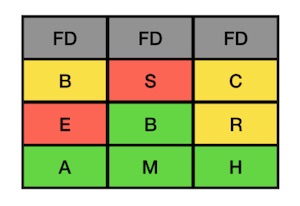
With the color coding meaning and letters mean:
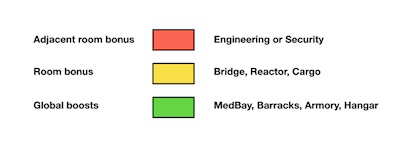
Security and Engineeringing Placement
There are several canonical placements of Security and Engineering. These rooms give adjacent buffs so their placement is important. However, because you can see adjacent room bonuses a room away, these rooms can help identify the room placement of all the entire carrier.
Visible vs Invisible
The first thing to diagnosing a defense whether adjacent room bonuses are visible on the flight deck. If they are visible, then we’ll call these defenses as being visible. Many defenses are invisible.
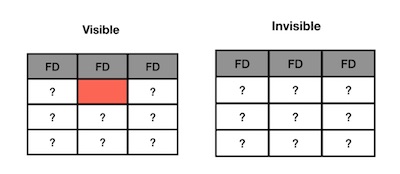
All things being equal, an invisible defense is better for defense, particularly if it encourages players down the wrong path. However, invisible defenses have several issues that we’ll discuss.
Meta-Layout: Vise:
Here Security and Engineering are placed in the first and third columns of the same row. The room in the middle is the vise and is typically a high value room with bonus like the Bridge or Reactor and that room is “in the vise.” The room in the vise is triple boosted.
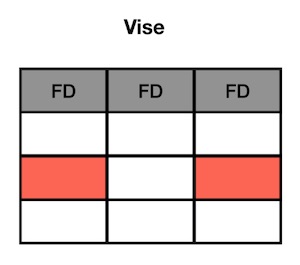
The three rows are called: “visible” for the 2nd, nothing for the 3rd, and “basement” for bottom. Typically the vise is on the 3rd row.
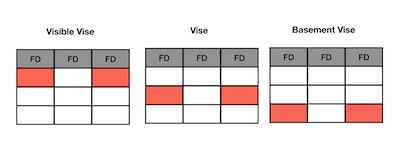
So a “visible bridge in the vise” would have the 2nd row have the Engineering-Bridge-Security as the three rooms (or flopping Engineering and Security).
The primary benefit of the vise is that it provides the possibility of a triple boost for the room in the middle of Engineering and Security. Below is a diagram showing the number of boosts each room has.
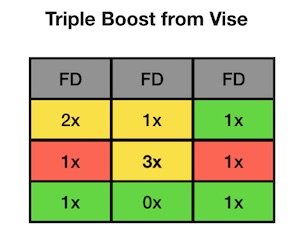
Variant: Basement Globals
Places the three dominant global boosts at the bottom.
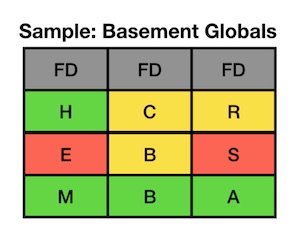
If someone takes FD1 or FD3 it takes 5 half rooms to get 1 global boosts, 7 half rooms to get 2 global boosts, 9 half rooms to get 3 global boosts, and 12 half rooms to get all 4 global boosts.
If the opposing alliance takes FD2, it takes 5 half rooms to get 1 global boost, 7 half rooms to get 2 global boosts, 9 half rooms to get 3 global boosts and 12 half rooms to get 4 global boosts.
Variant: 4 Corners
Place the 4 global boosts in the 4 corners of the defense giving them single boosts and the three single room boosts down the middle. This takes advantage of offensive strategies that go heavily down the middle. By not having any global boosts adjacent to each other, it means that it is difficult to get to all of the boosts.
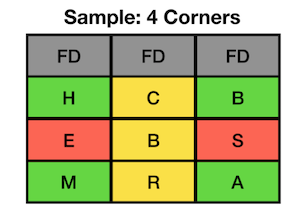
If the opposing alliance takes FD1 or FD3 this requires 3 half rooms to get the 1 global boost 6 half rooms to get 2 global boosts, 9 half rooms to get 3 global boosts and 12 half rooms to get 4 boosts — though this requires going down both sides separately.
If the opposing alliance takes FD2 and tunnels to the bottom and blows rooms then it requires 7 half rooms to get 1 global boost, 9 half rooms to get 2 global boosts, 12 half rooms to get 3 global boosts and 14 half rooms to get 4 global boosts.
Variant: Global Boost in Vise
This is probably one of the weakest layouts because while it double boosts a valuable room, it is often the third room that’s hit and then carrier and be easily maneuvered.

Meta-Layout: Firewall
A Firewall placement has Engineering and Security on the same row so that they give a double boost. The additional room on that row is typically a room with a boost like the Cargo Bay, Reactor or Bridge.
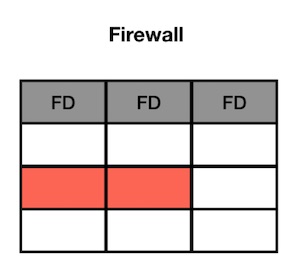
The three rows are called: visible for the second row, nothing for the third row, and “basement” for the bottom row (though it hardly is a firewall at that point). Typically the Firewall is on the third row.
So a “Cargo Bay Firewall” would be a Cargo Bay – Engineering – Security (or any of the other three orderings that keep Engineering and Security next to each other).
The primary benefit of a firewall is to keep the global boosts away from attack and to provide the maximal number of rooms with boosts.
Here is a common placement of rooms with a firewall:

The third row has double boosts all the way across. This means that if you place stout defenses all the way across, you can keep your global boosts safe from energy fire.
Meta-Layout: Visible Catty-Corner
A Catty-Corner defense have Engineering and Security diagonally touching each other. The purpose of this defense is to give two rooms double boosts. Either global boosts can be placed in these double boosts or boosted rooms giving them triple boosts.
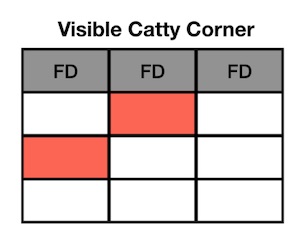
The catty-corner defense can be either on the top two rows (making it visible) or the bottom two rows (making it invisible).
The catty-corner be in either the left two columns or the right two columns. Then they can be outer or inner depending on whether the outer columns or inner column is higher. A Security in the 2nd row middle column with an Engineering in the 3rd left column would be a “visible inner left catty-corner defense.” A Security in the 2nd row middle column with an Engineering in the 3rd right column would be a “visible outer right catty-corner defense.”
Rarely do you have an invisible inner catty-corner defense because it places a buff in a corner where it only applies to 2 rooms.
Meta-Layout: Invisible Catty-Corner
A Catty-Corner defense have Engineering and Security diagonally touching each other. The purpose of this defense is to give two rooms double boosts.
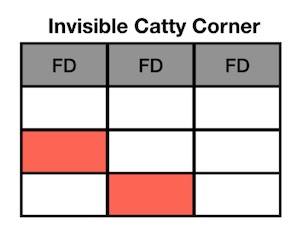
This is a common meta-defense amongst the common alliances. It has the benefit of being invisible and also having the two double boosted rooms.
The catty-corner be in either the left two columns or the right two columns. Then they can be outer or inner depending on whether the outer columns or inner column is higher. A Security in the 2nd row middle column with an Engineering in the 3rd left column would be a “visible inner left catty-corner defense.” A Security in the 2nd row middle column with an Engineering in the 3rd right column would be a “visible outer right catty-corner defense.”
Rarely do you have an invisible inner catty-corner defense because it places a buff in a corner where it only applies to 2 rooms.
The three dominant variants are described by how many global boost are placed in rooms with two corners with double adjacent room bonuses.
There is always one room that has a straight run down from the flight decks. This is the leading double boost room, while the one that is protected from the adjacent room bonus is the trailing double boost room.
Variant: Single Global
The single global variant of the invisible catty-corner defense is the most common. The leading double boost room is almost always the bonus room — Bridge, Cargo, or Reactor.
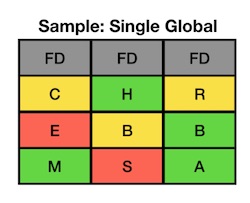
Strategy:
The weak point in this defense is the side that doesn’t the adjacent room bonuses.
Variant: Double Global
A less common variant is the double global, where two global boosts are given double protection.

Variant: No Global
The no global variant is less common and leaves all the globals exposed, particularly in the invisible variety.
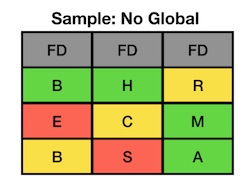
The purpose with this defense is to have people take FD2 and spend time going to the double boosted corner room. Having the boosts in opposites corners can slow down the opponent eliminating all of the global boosts.
Meta-Layout: Invisible Central Catty-Corner
This is a less common version of the Invisible Catty-Corner. Here, instead of having the bottom middle room having an adjacent room bonus, one of the corners does
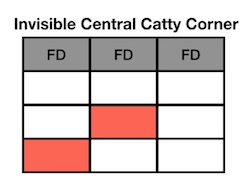
Variant: Single Global
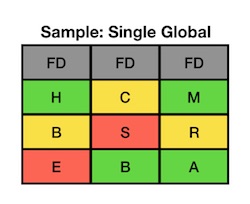
Meta-Layout: Pillar of Power
A Pillar of Power defense places Engineering and Security in the same column. These can be visible or invisible and can be left, right, or center. Typically it is a visible center pillar of power with the bridge underneath.

Variant: Three Column
The Three Column variant is one of the strong versions of the Pillar of Power defense. In this variant the three valuable global boosts are placed in different columns. This requires multiple horizontal tunnels to get to the globals boosts.

Date: 2020-06-23
Written by: Avenue Assassin








